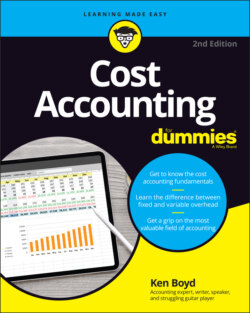Читать книгу Cost Accounting For Dummies - Kenneth W. Boyd - Страница 95
Charging customers for direct and indirect costs
ОглавлениеTo bill a customer and calculate a profit, you must add up all the costs for that customer, whether they are direct or indirect costs.
If, for example, you manufacture kitchen countertops, you would want to include all direct and indirect costs of a custom countertop installation in order to bill the customer. A direct cost might be marble (for material). To find the total cost of material for the job, you’d compute direct material cost as (marble) × (quantity used).
Indirect costs are different. If your kitchen countertop business makes lease payments on an office building, the cost is indirect. You can’t know the exact amount of indirect costs for the client. You also can’t trace the cost directly to a specific customer, but you can allocate it using a cost allocation base.
For job costs to be accurate, you need to collect information before you bill the client. You also need to consider the difference between your cost estimate and the final bill. Your client needs to understand how costs higher than the estimate will be handled. Should the customer expect to pay it, or will you absorb the cost (and lower your profit)? If this isn’t handled correctly, the customer may be upset. Unforeseen things happen, of course, and you should explain when you hand the customer the estimate that the final bill may be different. A customer would likely accept additional labor costs. That’s because the exact cost of labor is probably hard for you to predict.
Think about allocating indirect costs this way: There’s a dollar amount of cost to allocate (say, $100). You spread that cost over a group of customers, a level of production, or some other activity level. In this section, you see how that might work.
A carpenter owns trucks that require repair and maintenance expense. That cost can’t be traced to specific customers; instead, these indirect costs are allocated to a cost object. You find a “best” method to assign repair and maintenance expense to clients, perhaps labor hours worked for the customer.
The logic is that if you worked more hours for a specific customer, you probably used your truck more. If you used the truck more, that customer should absorb more of your truck’s repair and maintenance cost.
It’s virtually impossible to trace the repair and maintenance cost of the truck back to a specific customer. So you make your best educated guess to distribute the cost.
Cost allocation is the process of connecting an indirect cost to a cost object (see Chapter 2 for more). A cost pool is a grouping of similar costs. You can think of a cost pool as a bunch of similar cost objects thrown together. In this case, the cost object is a specific customer job.
A cost driver is an item that changes the total costs. If you drive the trucks more, they require more repair and maintenance. An activity (driving to see customers) drives up your costs (repair and maintenance).
Just to clarify: The cost object is the “sponge” that absorbs the cost. The cost driver adds to the size of the sponge. A bigger sponge absorbs more cost.
Assume the total repair and maintenance expense for three carpentry trucks is $3,000. During the month, your workers provide service to 300 clients. Each customer is allocated $10 of repair and maintenance expense ($3,000 ÷ 300 clients).
If the cost driver increased to 400 clients per month, the carpenters would drive more miles. As a result, the trucks would require more maintenance and possibly repairs. Your monthly repair and maintenance expense would be higher.
At 400 customers for the month, assume total repair and maintenance expense for three carpentry trucks is $3,600. Now each customer is allocated repair expense of $9 ($3,600 ÷ 400 clients). The cost driver increase (number of customers) changed your total cost to $3,600. Because you also have an increase in total customers (400), the $3,600 is spread over a larger group. The total cost increased, but the cost allocated per customer declined.
You can see how the cost allocation process can get complicated.
It’s often beneficial to group similar costs together into the same cost pool when the cost driver is the same. Consider a cost pool for the indirect costs for the carpentry trucks. In addition to repair and maintenance expense, the company pays for insurance and depreciation on the three trucks. None of these costs can be traced to a specific customer; instead, you need to allocate these costs. A good cost pool would include depreciation, insurance, and repair costs on the trucks. This cost pool can be allocated just like the repair and maintenance in the previous example.
